Tung Oil Vs Teak Oil: Which Wood Finish Reigns Supreme?
Making or restoring furniture is a labor of love where every detail matters. Among those details, the wood finish is at the top. And among the multitudes of finishes, tung oil, and teak oil have earned their stripes as tried-and-tested contenders.
So, tung oil vs teak oil, which is the true champion of wood finishing? Well, each of the two excels in various projects. For instance, tung oil would be better for furniture and surfaces that come into contact with water. Teak oil will be the best choice for projects that need the wood to have a hiney-like appearance.
Read on for more knowledge to make an informed choice between tung and teak oil.
An Overview of Tung Oil vs Teak Oil
Here is a table comparison between the two:
| Tung Oil | vs. | Teak Oil |
|---|---|---|
| Extracted from the nut of the tung tree. | Source | Combination of linseed oil and tung oil plus other additives |
| Slight amber hue. | Color Enhancement | Honey-toned, lustrous finish. |
| Suitable for various wood types. | Application Versatility | Effective on a variety of wood species. |
| Ideal for both indoor and outdoor projects. | Application | Excellent for outdoor projects with UV protection. |
| Slow drying, need patience | Drying Time | Quick drying time |
| Less durable | Durability | Maximum durability |
| Considered eco-friendly with pure, natural formulations. | Environmental Impact | Not eco-friendly |
| Low toxicity | Toxicity | Contains VOCs and lead |
Understanding Tung Oil
This oil is derived from seeds of the Tung tree (Aleuritrs fordii). Once harvested, the seeds are cleaned to remove debris and impurities. Their oil content is extracted via mechanical pressing, solvent extraction, or a combination of both methods.
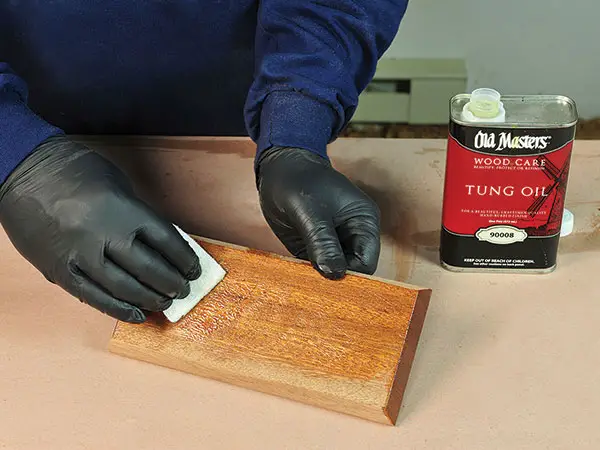
The extracted oil undergoes a filtration process to remove any solids and impurities. After, heat treatment is done to remove more residual solvents and impurities. No preservatives or chemicals are added. The pure oil is sold directly as it is.
Understanding Teak Oil
Teak oil is primarily a blend of linseed, tung, and other additives. These additives include mineral spirits, vanishes, lead, and so on, depending on the brand. The result is a finish that has a rich hue that is often described as resembling honey or aged whiskey, as shown in this video:
Choosing Between Tung Oil and Teak Oil
Follow these considerations to choose the best woodworking finish:

1. Wood Type
Tung oil is renowned for its adaptability across various wood types. Whether you are crafting a piece of dense hardwood like oak or a more porous type like pine, tung oil doesn’t discriminate.
Teak oil, on the other hand, also works effectively on a variety of wood species. Hence, both are good regardless of the wood you use in your project.
2. Application Environment
Tung oil is an excellent choice if your artwork will be used in outdoor spaces with lots of moisture. It has strong water-proof features, making it ideal for woodwork exposed to rain, humidity, or damp environments.

Teak oil shares tung oil’s outdoor resilience. However, it goes a further step by offering protection against UV rays. This property makes it particularly suitable for artwork that will not only be exposed to moisture but also to the harsh effects of the sun.
3. Aesthetics
Tung oil is renowned for its ability to enhance the wood’s natural color. It imparts a slight amber hue. This adds depth and character to the wood’s appearance. This warm and classic finish has a timeless appeal. It makes this finish a popular choice for those seeking traditional wood aesthetics.
Its counterpart, teak oil, is known for its honey-toned finish. This appearance highlights your wood’s natural beauty with a lustrous sheen. The result is an artwork that exudes warmth and sophistication. This makes it excellent if you are looking for a more refined finish.
If you need to have the original color of your wood, you are better with tung oil. It is known for keeping the original color of your wood. It will only add a slight amber hue. Teak oil, on the other hand, will discolor your wood, especially if it is very porous.
4. Ease of Application
Tung oil is known for its accessibility to woodworkers of all skill levels. To apply it, you just need a suitable method, either through a brush, wipe, or spray.
However, it is not as easy as its competitor, teak oil. The latter dries quickly in about 15 minutes. This allows you to have multiple coats seamlessly. It should be the go-to coat if you are looking for one that is easy to apply.
5. Maintenance and Durability
Both tung and teak oil maintenance routines are simple. To ensure your wood retains its protective coat and finish, you only need to have a periodic reapplication.
As for durability, teak oil wins here. It foams a coat on your artwork that prevents it from UV lights, scratches, moisture, and many other elements. It also penetrates deep into the wood and foams a hard coat that will withstand time.
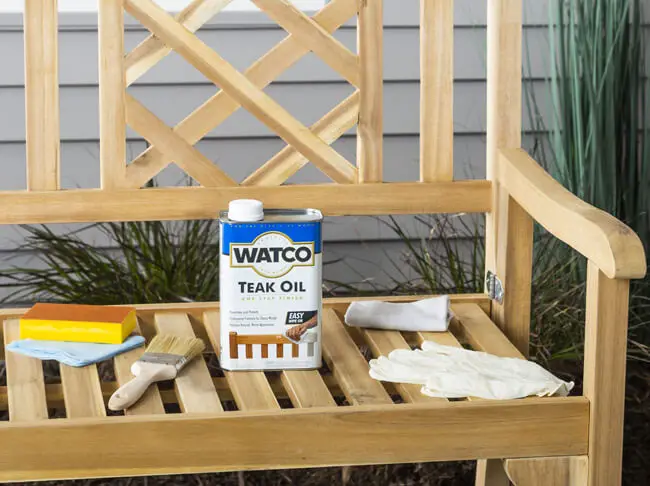
6. Indoor or Outdoor Use
Tung oil has a mild nutty scent that dissipates as it dries. This is well tolerated in an indoor setting. Its counterpart has a stronger odor.
If you will be doing all your coatings in indoor settings, you need tung oil. If you choose teak oil, you must go an extra step and ensure proper ventilation, or just use it outdoors.
7. Toxicity
Teak oil contains certain elements that warrant attention. The two significant components to be aware of are Volatile Organic Compounds (VOCs) and lead content. VOCs are organic chemicals that easily vaporize into the air at room temperature. Inhaling them will lead to respiratory irritation, headaches, dizziness, allergies, and asthma in serious cases.
While not all teak oils have lead, some might include lead-based compounds as stabilizers or additives. Inhaling is a serious health problem. It could affect your nervous system and impair development in children.
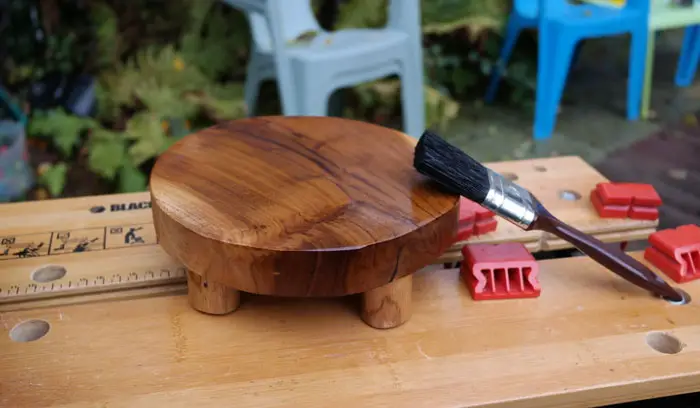
That’s why manufacturers always advise that you have a NIOSH-approved safety respirator, goggles, and gloves. You should also have proper ventilation when working with this oil.
Its counterpart, tung oil, is sold in its purest form. Hence, it is not toxic to your body. Neither does it release harmful byproducts that you should be worried about.
8. Environmental Considerations
Tung oil is sold in its pure form. Its manufacturing process doesn’t include adding any additives. Hence, it is environmentally friendly and sustainable. This would be the best choice if you are an environmental conservation enthusiast.
The same cannot be said about teak oil. Its manufacturing involves additions of chemicals and solvents that will impact the environment. However, recently, there are some eco-friendly options available that do not use toxic materials.
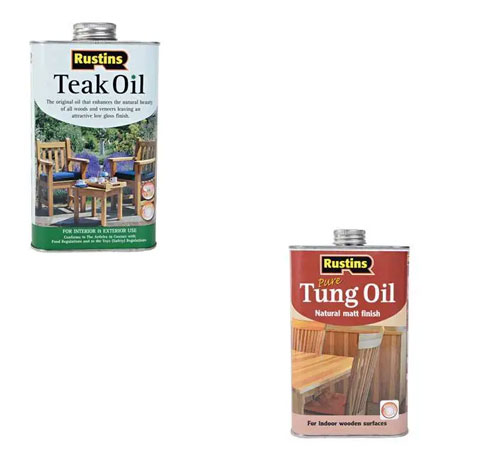
These options are more costly, but they allow you to enjoy the benefits of teak oil. While it will maintain a commitment to be environmentally responsible.
9. Price
Teak and tung oil have similar price points. You should expect to shell about $10 for 8 ounces. If you buy in bulk, you can get a deal of $10 for 10 ounces.
However, remember that this price will vary depending on the brand and the quality of the formulation. Known brands with high-quality formulations will be priced higher than generic or lower-quality alternatives.
10. Storage
Tung oil is natural and pure. Hence, its shelf life is limited compared to teak oil. Over time, tung oil can undergo polymerization, causing it to thicken and form a gum-like substance.
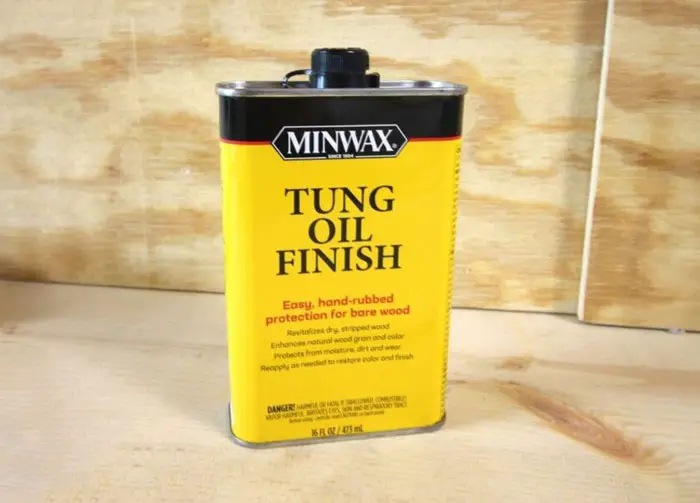
In contrast, teak oil can last up to 3 years on the shelf when stored in a cool, dry place and tightly sealed container. The extended lifespan is often attributed to the presence of stabilizers and additives in the oil.
FAQs
Here are answers to some of the questions that will come up as you read:
Q: How many coats do I need for tung and teak oil?
For tung oil, you need about five coats, depending on the application of the woodwork. If it’s going to an extreme environment, then apply five coats. The rest of the applications will be fine with three coats.
As for teak oil, you only need two coats. Even for the most demanding uses, two coats are enough.
Q: Which oil should I use for my cutting board?
Tung oil is the safest option if the cutting board will be used in the kitchen. It is natural and contains no additives or chemicals that could leach into your food.
Q: Can I mix tung and teak oil for a custom finish?
No. We do not recommend mixing different types of finishes. The two have different formulations and drying times. Mixing them will only lead to unpredictable results. Just choose a product that meets your requirements and stick to it.
Conclusion
The debate on tung oil vs teak oil has produced no clear winner. Both of the oils excel in their own dynamics. For instance, tung oil is less toxic, environmentally friendly, and food safe. On the other hand, teak oil offers more protection, quick drying times, and fewer coats needed.
Ultimately, the choice between the two depends on the woodwork project you intend to undertake. Carefully consider your finish specification and make an informed choice between the two.




